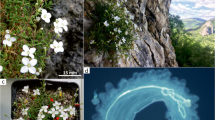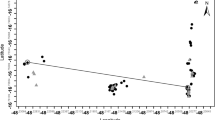Summary
The mating system of Hydrophyllum appendiculatum (Hydrophyllaceae), a protandrous, self-compatible, monocarpic plant was examined using progeny arrays assayed at three polymorphic allozyme loci. We were particularly interested in the effect of ecological factors on spatial and temporal variation in outcrossing rates. Multilocus estimates of outcrossing rates in three populations ranged from 0.62–0.81 indicating that the majority of seeds are produced via outcrossing. The population estimates did not differ significantly from each other indicating that there is little or no spatial variation in the mating system of this species. The estimates were, however, significantly less than unity, which demonstrates that although mainly outcrossing, a significant fraction of seeds are produced by selfing. Estimates suggested that biparental inbreeding occurred, although it was statistically significant in only one population. Individuals of H. appendiculatum may remain in anthesis 3–4 weeks and produce up to 30 inflorescences. As a result, the possibility exists for the mating system to vary through the flowering season. Although the mean outcrossing rate was highest in the middle of the flowering phenology than at the beginning or end, there was no evidence for statistically significant temporal heterogeneity. We were also interested in determining if the size of the floral display (number of inflorescences produced by a plant) influenced the outcrossing rate. The results obtained by two different statistical analyses were contradictory; there was a significant positive correlation between size of floral display and outcrossing rate, but the outcrossing rates of large plants (\s> 8 inflorescences) did not differ significantly from small plants (> 8 inflorescences).
Similar content being viewed by others
References
Abbott RJ, Irwin JA (1988) Pollinator movements and the polymorphism for outcrossing rate at the ray floret locus in Groundsel, Senecio vulgaris L. Heredity 60:295–298
Aide TM (1986) The influence of wind and animal pollination on variation in outcrossing rates. Evolution 40:434–435
Barrett SCH, Eckert CG (1990) Variation and evolution of mating systems in seed plants. In: Kawano S (ed) Biological approaches and evolutionary trends in plants. Academic Press, New York, pp 229–254
Barrett SCH, Husband BC (1990) Variation in outcrossing rates in Eichhornia paniculata: The role of demographic and reproductive factors. Plant Species Biol 5:41–55
Barrett SCH, Shore JS (1987) Variation and evolution of breeding systems in the Turnera ulmifolia complex (Turneraceae). Evolution 41:340–354
Brown AHD, Grant JE, Pullen R (1987) Outcrossing and paternity in Glycine argyrea by paired fruit analysis. Biol J Linn Soc 29:283–294
Brown BA, Clegg MT (1984) Influence of flower color polymorphism on genetic transmission in a natural population of the common morning glory, Ipomoea purpurea. Evolution 38:796–803
Burdon JJ, Jarosz AM, Brown AHD (1988) Temporal patterns of reproduction and outcrossing in weedy populations of Echium plantagineum. Biol J Linn Soc 34:81–92
Charlesworth D, Charlesworth B (1987) Inbreeding depression and its evolutionary consequences. Annu Rev Ecol Syst 18:237–268
Charlesworth D, Morgan MT, Charlesworth B (1990) Inbreeding depression, genetic load, and the evolution of outcrossing rates in a multilocus system with no linkage. Evolution 44:1469–1489
Clegg MT (1980) Measuring plant mating systems. Bioscience 30:814–818
Darwin C (1876) The effects of cross and self fertilization in the vegetable kingdom. John Murray, London
Dudash MR, Barrett SCH (1989) The influence of environmental and demographic factors on the mixed mating system of Sabatia angularis. Am J Bot 76 [Suppl]: 99–100 (abstr)
Ellstrand NC, Torres AM, Levin DA (1978) Density and the rate of apparent outcrossing in Helianthus annum (Asteraceae). Syst Bot 3:403–407
Ennos RA (1981) Quantitative studies of mating system in two sympatric species of Ipomoea (Convolvulaceae). Genetica 57:93–98
Ennos RA, Clegg MT (1982) Effect of population substructuring on estimates of outcrossing rate in plant populations. Heredity 48:283–292
Fripp YJ, Griffin AR, Moran GF (1987) Variation in allele frequencies in the outcross pollen pool of Eucalyptus regnans. F Muell throughout a flowering season. Heredity 59:161–171
Gleason HA, Cronquist A (1963) Manual of vascular plants of Northeastern United States and adjacent Canada. Willard Grant Press, San Francisco
Glover DE, Barrett SCH (1986) Variation in the mating system of Eichhornia paniculata (Spreng) Solms. (Pontederiaceae). Evolution 40:1122–1131
Hedrick RW, Ritland K (1990) Gametic disequilibrium and multilocus estimation of selfing rates. Heredity 65:343–347
Holsinger KE (1988) Inbreeding depression doesn't matter: the genetic basis of mating-system evolution. Evolution 42:1235–1244
Holtsford TP, Ellstrand NC (1990) Inbreeding effects in Clarkia tembloriensis (Onagraceae) populations with different natural outcrossing rates. Evolution 44:2031–2046
Horovitz A, Harding J (1972) Genetics of Lupinus V. Intraspecific variability for reproductive traits in Lupinus nanus. Bot Gaz 133:155–165
Lande R, Schemske DW (1985) The evolution of self-fertilization and inbreeding depression in plants. I. Genetic models. Evolution 39:24–40
Levin DA (1981) Dispersal versus gene flow in plants. Ann Mo Bot Gard 68:233–253
Lloyd DG, Webb CJ (1986) The avoidance of interference between the presentation of pollen and stigmas in angiosperms. I. Dichogamy. NZ J Bot 24:135–162
Moran GF, Brown AHD (1980) Temporal heterogeneity of outcrossing rates in alpine ash (Eucalyptus delegatensis RT Bak). Theor Appl Genet 57:101–105
Morgan MT, Barrett SCH (1990) Outcrossing rates and correlated mating within a population of Eichhornia paniculata (Pontederiaceae). Heredity 64:271–280
Piper JG, Charlesworth B, Charlesworth B (1984) A high rate of self-fertilization and increased seed fertility of homostyle primroses. Nature 310:50–51
Ritland K (1989) Correlated matings in the partial selfer Mimulus guttatus. Evolution 43:848–859
Ritland K (1990) A series of FORTAN computer programs for estimating plant mating systems. J Hered 81:235–237
Ritland K, Ganders FR (1985) Variation in the mating system of Bidens menziesii (Asteraceae) in relation to population substructure. Heredity 55:235–244
Ritland K, Jain SK (1981) A model for the estimation of outcrossing rate and gene frequencies using n independent loci. Heredity 47:35–52
Ritland K, El-Kassaby YA (1985) The nature of inbreeding in a seed orchard of Douglas Fir as shown by an efficient multilocus model. Theoret Appl Genet 71:375–384
Schaal BA (1980) Measurement of gene flow in Lupinus texensis. Nature 284:450–451
Schemske DW, Lande R (1985) The evolution of self-fertilization and inbreeding depression in plants. II. Empirical observations. Evolution 39:41–52
Schoen DJ (1982) The breeding system of Gilia achilleifolia: variation in floral characteristics and outcrossing rate. Evolution 36:352–360
Schoen DJ, Clegg MT (1984) Estimation of mating system parameters when outcrossing events are correlated. Proc Natl Acad Sci USA 81:5258–5262
Schoen DJ, Clegg MT (1985) The influence of flower color on outcrossing rate and male reproductive success in Ipomoea purpurea. Evolution 39:1242–1249
Shaw DV, Allard RW (1982) Estimation of outcrossing rates in Douglas-fir using isozyme markers. Theor Appl Genet 62:113–120
Shaw DV, Kahler AL, Allard RW (1981) A multilocus estimator of mating system parameters in plant populations. Proc Natl Acad Sci USA 78:1298–1302
Shore JS, Barrett SCH (1987) Inheritance of floral and isozyme polymorphisms in Turner a ulmifolia L. J Hered 78:44–48
Vasek FC, Harding J (1976) Outcrossing in natural populations. V. Analysis of outcrossing, inbreeding and selection in Clarkia exilis and Clarkia tembloriensis. Evolution 3:403–411
Watkins L, Levin DL (1990) Outcrossing rates as related to plant density in Phlox drummondii. Heredity 65:81–89
Waller DM, Knight SE (1989) Genetic consequences of outcrossing in the cleitogamous annual, Impatiens capensis. II. Outcrossing rates and genotypic correlations. Evolution 43:860–869
Wolfe LM (1990) Regulation of reproductive success in Hydrophyllum appendiculatum, a biennial plant. Ph D thesis, University of Illinois
Wolfe LM, Barrett SCH (1989) Patterns of pollen removal and deposition in tristylous Pontederia cordata L. (Pontedericeae). Biol J Linn Soc 36:317–329
Author information
Authors and Affiliations
Rights and permissions
About this article
Cite this article
Wolfe, L.M., Shore, J.S. The mating system of Hydrophyllum appendiculatum, a protandrous species. Sexual Plant Reprod 5, 239–245 (1992). https://doi.org/10.1007/BF00189818
Issue Date:
DOI: https://doi.org/10.1007/BF00189818




